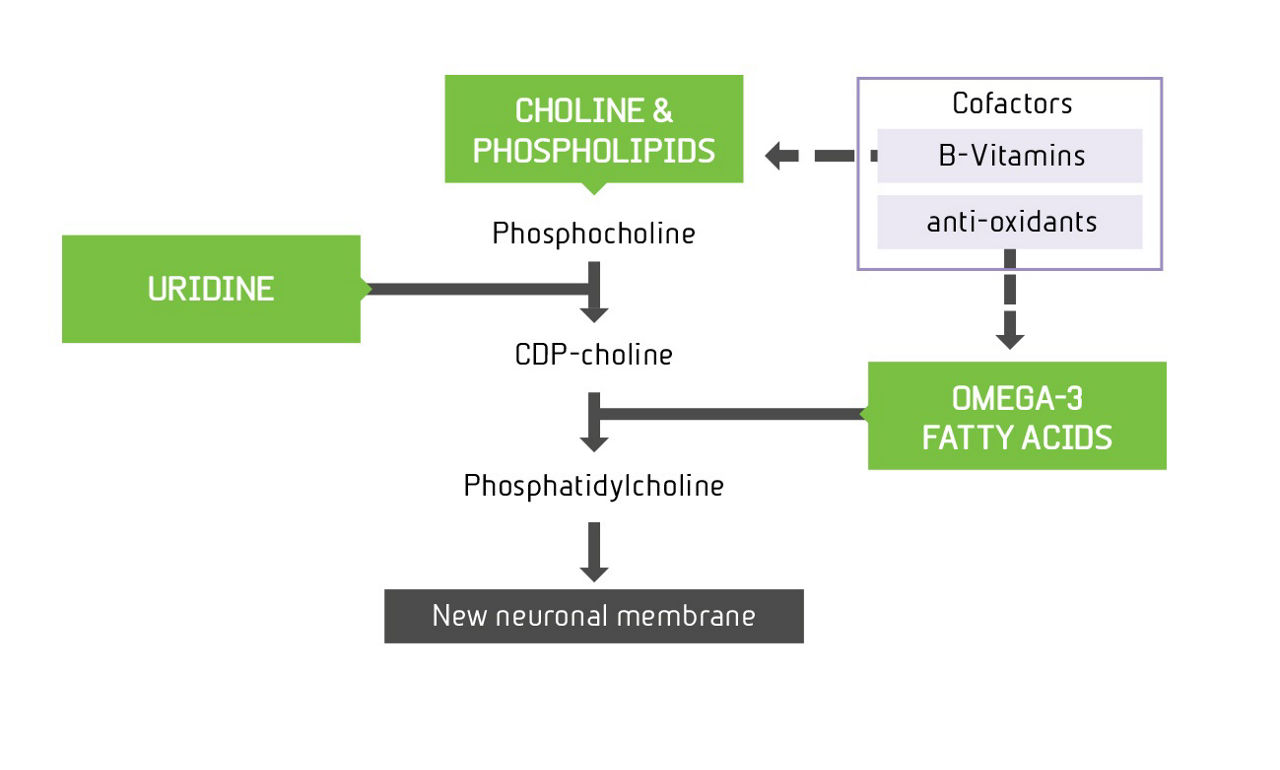How does Souvenaid work?
Souvenaid is a medical nutrition product that contains a unique patented combination of nutrients designed to support synapse formation in early Alzheimer's disease19
Souvenaid - a nutritional approach in early Alzheimer's disease
Souvenaid is a medical nutrition product that contains a unique, patented combination of nutrients designed to support synapse formation. Souvenaid, addresses the specific nutritional requirements of the Alzheimer's disease patient19.
Synapse loss in Alzheimer's disease
Compared to other hallmarks of Alzheimer's disease, synapse loss corrrelates best with impaired memory1-3. Synapses are continuously being remodelled, and synapse formation depends on the production of neuronal membranes, which primarly consist of phospholipds4,5.
Fortasyn Connect™ - providing the nutritional components for synapse formation
The unique combination of nutritional precursors and cofactors in Souvenaid is known under the name Fortasyn Connect. These components work together to enhance phospholipid synthesis via the Kennedy pathway6-16 (Figure 1), and include specific precursors of phosphatidylcholine, the most abundant phospholipid in the brain:
- Long chain omega-3 polyunsaturated fatty acids (PUFAs) - docosahexaenoic acid (DHA) and eicosapentaenoic (EPA)
- Uridine supplied as uridine monophosphate (UMP)
- Choline
Fortasyn Connect also contains the following cofactors, all of which synergistically enhance bioavailability of the aforementioned three main precursors to enhance phospholipid synthesis:
- B vitamins
- Phospholipids
- Vitamin E
- Vitamin C
- Selenium
Figure 1: The biochemical pathway for synthesising new neuronal membranes

Adapted from Ritchie CW et al (2014)
The increased phospholipid synthesis supports the formation of neuronal membranes9. Preclinical models combining these nutritional precursors have demonstrated neurite outgrowth, increased dendritic spines density, increased levels of pre- and post-synaptic proteins, and improved learning6,8,12-13,17-18.
- Terry RD, et al. Physical basis of cognitive alterations in Alzheimer’s disease: Synapse loss is the major correlate of cognitive impairment. Ann Neurol, 1991; 30: 572-580.
- Terry RD. Alzheimer’s disease and the aging brain. J Geriatr Psychiatry Neurol, 2006; 19: 125-128.
- Scheff SW, et al. Hippocampal synaptic loss in early Alzheimer’s disease and mild cognitive impairment. Neurobiol Aging, 2006; 27: 1372-1384.
- Yi JJ and Ehlers MD. Ubiquitin and protein turnover in synapse function. Neuron, 2005; 47: 629-632.
- Kennedy EP and Weiss SB. The function of cytidine coenzymes in the biosynthesis of phospholipides. J Biol Chem, 1956; 222: 193-214.
- Wurtman RJ, et al. Synaptic proteins and phospholipids are increased in gerbil brain by administering uridine plus docosahexaenoic acid orally. Brain Res, 2006; 1088: 83-92.
- Cansev M, et al. Restorative effects of uridine plus docosahexaenoic acid in a rat model of Parkinson’s disease. Neurosci Res, 2008; 62: 206-209.
- Sakamoto T, et al. Oral supplementation with docosahexaenoic acid and uridine-5′-monophosphate increases dendritic spine density in adult gerbil hippocampus. Brain Res, 2007; 1182: 50-59.
- Holguin S, et al. Chronic administration of DHA and UMP improves the impaired memory of environmentally impoverished rats.Behav Brain Res, 2008; 191: 11-16.
- Holguin S, et al. Dietary uridine enhances the improvement in learning and memory produced by administering DHA to gerbils. FASEB J., 2008; 22: 3938-3946.
- Cansev M, et al. Giving uridine and/or docosahexaenoic acid orally to rat dams during gestation and nursing increases synaptic elements in brains of weanling pups. Dev Neurosci., 2009; 31: 181-192.
- Cansev M and Wurtman RJ. Chronic administration of docosahexaenoic acid or eicosapentaenoic acid, but not arachidonic acid, alone or in combination with uridine, increases brain phosphatide and synaptic protein levels in gerbils. Neuroscience, 2007; 148: 421-431.
- Wang L, et al. Dietary supplementation with uridine-5′-monophosphate (UMP), a membrane phosphatide precursor, increases acetylcholine level and release in striatum of aged rat. Brain Res., 2007; 1133: 42-48.
- Richardson UI, et al. Stimulation of CDP-choline synthesis by uridine or cytidine in PC12 rat pheochromocytoma cells. Brain Res., 2003; 971: 161-167.
- Richardson UI and Wurtman RJ. Polyunsaturated fatty acids stimulate phosphatidylcholine synthesis in PC12 cells. Biochim Biophys Acta., 2007; 1771: 558-563.
- van Wijk N, et al. Plasma choline concentration varies with different dietary levels of vitamins B6, B12 and folic acid in rats maintained on choline-adequate diets. Br J Nutr., 2012; 107: 1408-12.
- Ulus IH, et al. Cytidine and uridine increase striatal CDP-choline levels without decreasing acetylcholine synthesis or release.Cell Mol Neurobiol., 2006; 26: 563-577.
- Pooler AM, et al. Uridine enhances neurite outgrowth in nerve growth factor-differentiated PC12. Neuroscience, 2005; 134: 207-214.
- Ritchie, CW et al Souvenaid: A new approach to management of early Alzheimer’s disease. The journal of nutrition, health & aging, 2014; 18(3): 291-299.
- Scheff et al. Journal of Alzheimer’s Disease, 2006; Vol 9,.
- Olesen MA et al. Redux biology Elseevir V34, 2020.
- Masliah et al. Neuroscience letters, 1994.
- Peters et al. Mo Neurodegener, 2006.
- Gold & Budsen. Expert Review of Neurotherapeutics (2008).
- Selkoe D et al. Science Vol 298 (2002).
- Scheff et al. Journal of Alzheimer’s Disease, 2011.
- Spierling et al. Alz & Dem, 2011.
- Cansev et al. Brain Res, 2005.
- Wang et al. Journal of Molecular Neuroscience, 2005.
- DeWilde et al. Brain Res, 2003.
- Farkas et al. Brain Res, 2002.
- Kariv-Inbbal et al. JAD, 2012.
- Grimm et al. JBC, 2011.
- Teather at al. PNPB, 2003.
- deWilde et al. Brain Res, 2003.
- deWilde et al. Brain Res, 2002.
- deBruin et al. J Learn Mem, 2003.
- Van Wijk et al. JAD, 2014.
- deWilde et al. JAD, 2011.
- Jansen et al. PLOS ONE, 2013.
- Broersen et al. JAD, 2013.
- Savelkoul et al. AAIC, 2012.
- Zerbi et al. Neurobiol Ageing, 2013.
- Savelkoul et al. ADPD, 2011.
- Savelkoul et al. J Neurochem, 2012.
- Bourre. J Nutr Health Aging, 2006a,b.
- Bourre. J Nutr Health Aging, 2005; 3.
- Phillips et al. Nutr Neurosci, 2012.
- van Wijk et al. J Alzheimers Dis, 2013.
- Lopes da Silva et al. Alheimers Dement, 2013.


